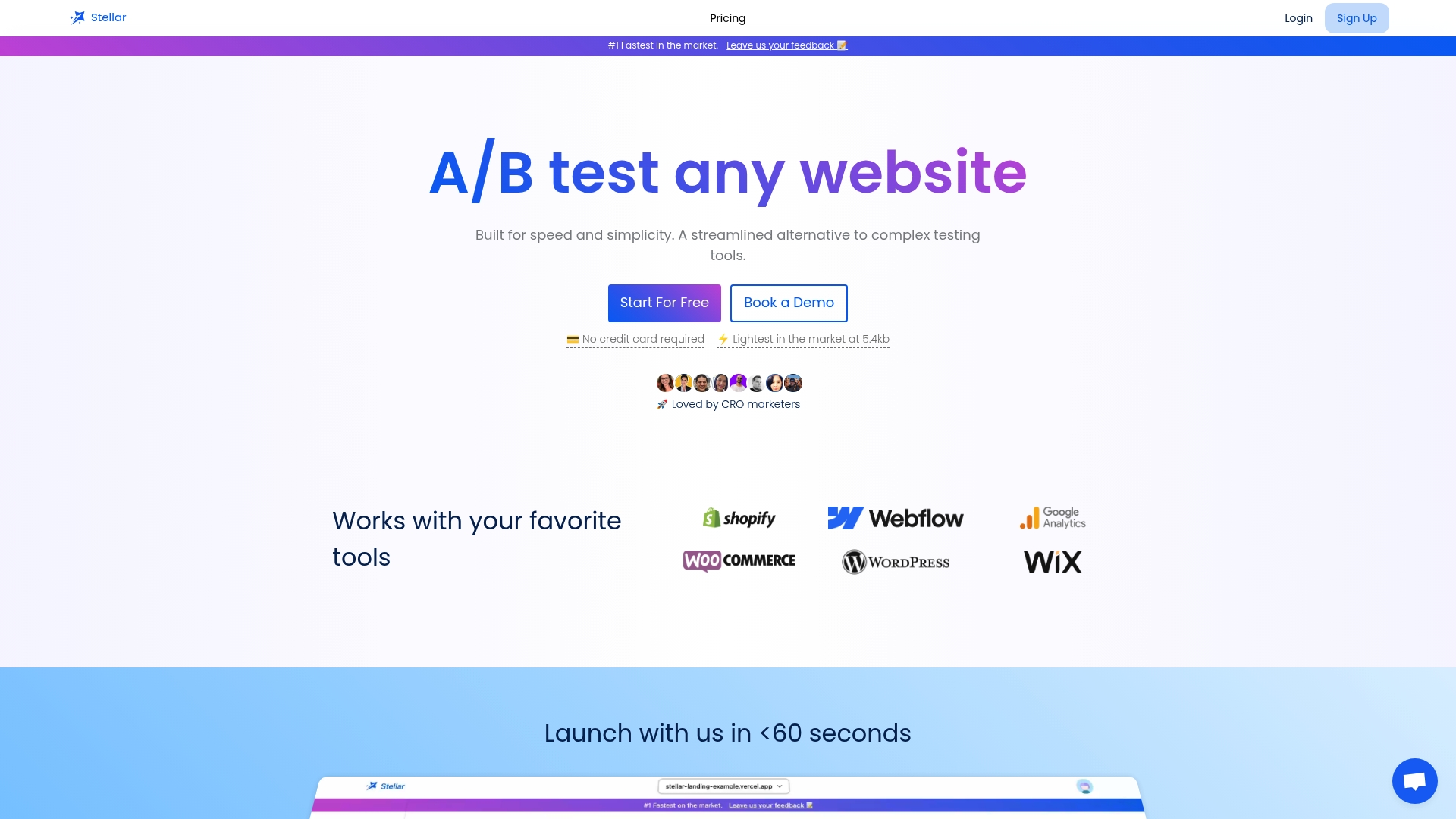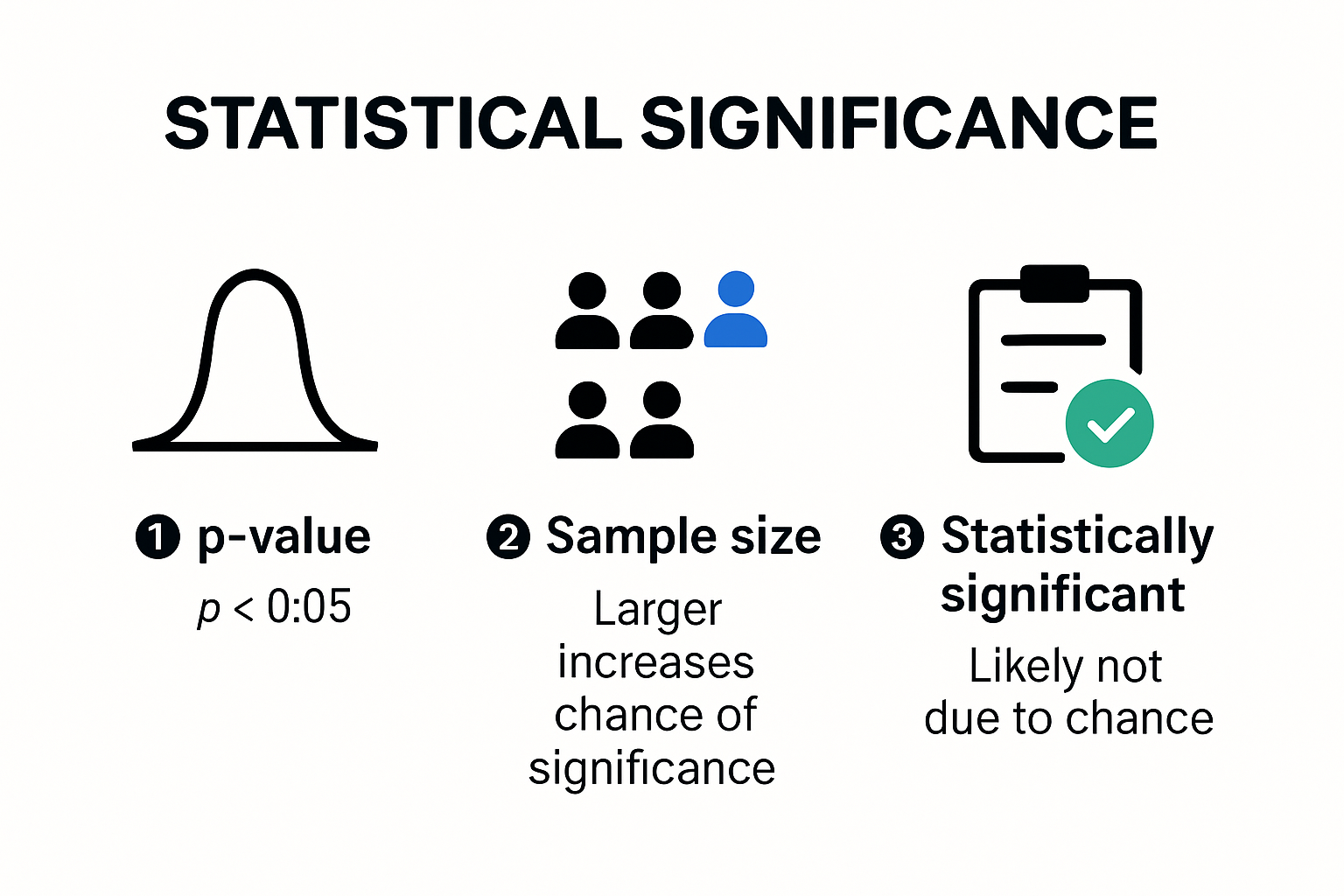
A/B Testing Significance: 2025 Guide for Marketers & CROs

Marketers love to tout every tiny win from A/B testing, but the real value often gets buried under quick results and impressive graphs. Here’s the twist. A staggering conversion rate improvement of up to 400 percent has been achieved by organizations that actually understand and apply statistical significance the right way. Most A/B test outcomes are meaningless unless you know how to separate real breakthroughs from random flukes—this is where things get interesting.
Table of Contents
- Understanding Statistical Significance In A/B Testing
- The Mathematical Foundation Of Statistical Significance
- Interpreting Statistical Significance In Practical Scenarios
- Avoiding Common Statistical Significance Pitfalls
- Common Pitfalls And Misinterpretations To Avoid
- Premature Test Termination And Sample Size Errors
- Overlooking Contextual Factors And Measurement Bias
- Narrow Metric Focus And Unintended Consequences
- How To Achieve Reliable A/B Test Results
- Establishing Robust Experimental Design
- Selecting Appropriate Statistical Methodologies
- Integrating Advanced Technologies And Qualitative Insights
- Applying Significance Insights To Drive Growth
- Quantifying Business Impact Through Experimental Insights
- Strategic Implementation Of Experimental Findings
- Integrating Advanced Analytics And Experimental Frameworks
Quick Summary
| Takeaway | Explanation |
|---|---|
| Understand Statistical Significance | Statistical significance indicates whether observed differences in A/B tests are genuine and not due to random chance, typically measured with a p-value below 0.05. |
| Avoid Common Pitfalls | Marketers should avoid prematurely terminating tests, overlooking sample size needs, and ignoring external factors that could skew results to maintain data integrity. |
| Establish Robust Experimental Design | A/B tests should have clear, measurable objectives, isolate one variable, and follow predetermined test durations to ensure reliable outcomes. |
| Integrate Advanced Analytics | Utilizing AI and advanced analytical methods enhances A/B testing reliability by improving data processing and identifying patterns, while complementing qualitative insights. |
| Leverage for Business Impact | Successfully applying A/B testing insights can lead to significant conversion rate improvements and guide strategic decisions in user experience and marketing tactics. |
Understanding Statistical Significance in A/B Testing
Statistical significance represents the scientific validation of A/B testing results, transforming raw data into actionable insights for marketers and conversion rate optimization (CRO) professionals. When conducting A/B tests, understanding statistical significance means determining whether the observed differences between test variations are genuine effects or simply random fluctuations.
The Mathematical Foundation of Statistical Significance
At its core, statistical significance measures the probability that test results occurred by chance. Research from Statsig reveals that statistical significance is typically determined by a p-value below 0.05, which indicates less than a 5% probability that observed differences are due to random variation. This mathematical threshold provides a robust framework for interpreting test outcomes.
Marketers use statistical significance to confidently make data-driven decisions. Convertize's statistical analysis framework emphasizes that significant results confirm the reliability of experimental findings, ensuring that proposed changes are not mere coincidences but represent genuine improvements.
Interpreting Statistical Significance in Practical Scenarios
Understanding statistical significance goes beyond mathematical calculations. It requires a nuanced approach to interpreting test results. Fibr.ai's testing framework highlights that statistical significance confirms whether test outcomes are meaningful for strategic decision-making.
Consider a typical conversion rate optimization scenario: you're testing two landing page designs. One variant shows a 10% conversion rate improvement over the control. However, without proper statistical validation, this improvement could be misleading. Statistical significance helps determine whether this increase represents a genuine performance enhancement or falls within expected random variation.
Key considerations for interpreting statistical significance include:
- Sample Size: Larger sample sizes provide more reliable results
- Confidence Level: Typically set at 95% for most marketing experiments
- Consistency of Results: Repeated tests should show similar patterns

Avoiding Common Statistical Significance Pitfalls
Marketers must be cautious about misinterpreting A/B test results. Common mistakes include:
- Stopping tests prematurely before reaching statistical significance
- Overlooking sample size requirements
- Failing to account for external variables
To maximize the value of A/B testing, professionals should learn more about experimental design and develop a rigorous approach to statistical analysis.
Statistical significance transforms A/B testing from a guessing game into a precise, data-driven methodology. By understanding and applying these principles, marketers can make confident, evidence-based decisions that drive meaningful improvements in conversion rates and overall business performance.
Common Pitfalls and Misinterpretations to Avoid
A/B testing provides powerful insights, but without careful execution, marketers can fall prey to numerous strategic errors that compromise data integrity and decision-making. Understanding these potential pitfalls is crucial for maintaining the reliability and effectiveness of your experimentation process.
Premature Test Termination and Sample Size Errors
Research from Wudpecker highlights a critical mistake many marketers make: stopping A/B tests too early. Premature test termination can lead to statistically invalid conclusions and misguided strategic decisions.
Marketers often fall into the trap of concluding tests before reaching adequate sample sizes or statistical significance. This error can manifest in several ways:
- Stopping a test when initial results seem promising
- Not running tests long enough to capture representative user behavior
- Making decisions based on insufficient data volume
To avoid these pitfalls, establish clear test duration parameters before launching an experiment. Fibr.ai's testing methodology recommends determining sample size requirements in advance and committing to a predetermined test duration that ensures robust statistical validity.
Overlooking Contextual Factors and Measurement Bias
External variables can significantly impact A/B test results, creating misleading interpretations. Wudpecker's comprehensive analysis reveals several critical contextual factors that can distort experimental outcomes:
- Seasonality Effects: Holiday periods or seasonal trends can artificially inflate or deflate conversion rates
- Concurrent Marketing Campaigns: Simultaneous promotional activities can introduce uncontrolled variables
- Product Update Interactions: Recent feature launches or website modifications can impact test results
Successful A/B testing requires a holistic approach that accounts for these potential interference factors. Marketers should design experiments that isolate the specific variable being tested and control for external influences.
Narrow Metric Focus and Unintended Consequences
Focusing exclusively on a single performance metric can lead to suboptimal decision-making. While conversion rate might improve, other critical user experience indicators could simultaneously decline. Research indicates that tracking multiple key performance indicators (KPIs) provides a more comprehensive understanding of test outcomes.
To develop a nuanced testing strategy, consider monitoring:
- Conversion rates
- Bounce rates
- User engagement metrics
- Long-term customer value
- Retention rates
Professionals can explore advanced experimental design techniques to enhance their testing methodology and avoid these common interpretational traps.
By recognizing and mitigating these potential pitfalls, marketers can transform A/B testing from a potential source of misleading data into a precise, reliable mechanism for continuous improvement and strategic optimization.
How to Achieve Reliable A/B Test Results
Achieving reliable A/B test results requires a strategic approach that goes beyond basic experimentation. Marketers must develop a systematic methodology that ensures data integrity, minimizes bias, and produces actionable insights.
Establishing Robust Experimental Design
Sales Duo's comprehensive testing guide emphasizes the critical importance of setting clear goals and maintaining experimental discipline. Successful A/B testing demands a meticulous approach to experimental design, starting with precise objective definition.
Key principles for creating reliable test frameworks include:
- Define specific, measurable objectives before launching the test
- Isolate a single variable to ensure clear cause-and-effect understanding
- Determine appropriate test duration and sample size requirements
- Establish control and variant groups with statistically significant population sizes
Professionals must commit to running tests for a minimum of two to three weeks, allowing sufficient time to capture representative user behavior and minimize statistical noise.
Selecting Appropriate Statistical Methodologies
Kameleoon's advanced testing framework reveals the critical nuance in choosing between frequentist and Bayesian statistical approaches. Each methodology offers unique advantages for interpreting experimental results:
- Frequentist Methods: Require fixed test duration and provide binary significance conclusions
- Bayesian Methods: Offer ongoing probability estimates that evolve with data collection
- Hybrid Approaches: Combine multiple statistical techniques for comprehensive analysis
The choice of statistical method can dramatically impact the interpretation and reliability of test results. Marketers should carefully consider their specific context and research objectives when selecting an analytical approach.
Integrating Advanced Technologies and Qualitative Insights
Research from Infinity Concepts highlights the emerging role of AI-powered tools in enhancing A/B testing reliability. Modern marketers can leverage technological advancements to:
- Accelerate data analysis processes
- Predict potential outcomes with greater accuracy
- Identify subtle patterns human analysts might overlook
However, technology should complement, not replace, comprehensive research methodologies. Learn more about data-driven experimentation techniques to develop a holistic approach that balances quantitative analysis with qualitative understanding.
Critical to reliable testing is maintaining a balance between technological capabilities and human insight. AI and advanced statistical tools provide powerful analytical support, but the most successful marketers combine these technologies with deep domain expertise and nuanced interpretation.
Reliable A/B testing is not about generating data, but about creating meaningful, actionable insights that drive strategic decision-making. By implementing rigorous experimental design, selecting appropriate statistical methods, and integrating advanced technologies, marketers can transform A/B testing from a simple measurement tool into a sophisticated optimization strategy.
Applying Significance Insights to Drive Growth
Transforming A/B testing insights into tangible business growth requires a strategic approach that goes beyond statistical analysis. Marketers must learn to translate significant test results into actionable strategies that drive meaningful organizational performance.
Quantifying Business Impact Through Experimental Insights
Research from Science and Technology Today reveals remarkable potential for growth, with organizations achieving conversion rate improvements up to 400% through systematic experimentation. These substantial gains underscore the transformative power of data-driven decision-making.
Enterprise Apps Today highlights that over 50% of marketers consider A/B testing essential for enhancing conversion rates and optimizing marketing strategies. This statistic demonstrates the critical role of experimental insights in modern business growth methodologies.
Key areas where significance insights drive organizational performance include:
- Conversion rate optimization
- User experience enhancement
- Marketing message refinement
- Product feature development
- Customer acquisition strategies
Strategic Implementation of Experimental Findings
Successful growth strategies demand more than statistical validation. Companies like Bing have demonstrated how precise experimental insights can translate directly into financial performance. Research indicates that strategic A/B testing can generate revenue increases between 10% to 25% by systematically improving user experiences.
To effectively apply significance insights, organizations should:
- Develop a continuous experimentation culture
- Create cross-functional teams that understand statistical methodologies
- Implement robust tracking and analysis frameworks
- Encourage data-driven decision-making at all organizational levels
Integrating Advanced Analytics and Experimental Frameworks
Modern growth strategies require sophisticated approaches to interpreting experimental data. Learn more about advanced analytics techniques to transform raw test results into comprehensive business strategies.
Advanced organizations are moving beyond simple conversion metrics, developing holistic approaches that consider:
- Long-term customer lifetime value
- Comprehensive user journey mapping
- Predictive performance modeling
- Behavioral segmentation insights
The most successful businesses view A/B testing not as a tactical tool, but as a strategic framework for continuous improvement. By treating experimental insights as a core component of organizational learning, companies can create adaptive, responsive strategies that evolve with changing market dynamics.
Ultimately, applying significance insights is about creating a data-driven culture that values empirical evidence over intuition. Organizations that master this approach can transform A/B testing from a marketing technique into a fundamental driver of sustainable business growth.
Frequently Asked Questions
What is statistical significance in A/B testing?
Statistical significance indicates whether the observed differences in A/B tests are genuine or simply due to random chance. Typically, a p-value below 0.05 signifies that the results are statistically significant.
How can I avoid common pitfalls in A/B testing?
To avoid pitfalls such as premature test termination or overlooking sample size, ensure you establish clear test objectives, maintain a suitable sample size, and run tests for a predetermined duration to capture meaningful data.
What are the key principles for reliable A/B test results?
Key principles include defining measurable objectives, isolating a single variable, selecting appropriate statistical methodologies, and integrating both quantitative and qualitative insights during analysis.
How can A/B testing insights drive business growth?
A/B testing insights can lead to business growth by informing conversion rate optimization, enhancing user experience, refining marketing strategies, and facilitating data-driven decisions that align with organizational goals.
Eliminate Guesswork and Unlock True A/B Test Insights
You’ve just discovered how vital statistical significance is to reliable A/B testing. Struggling to achieve trustworthy results? Tired of stopping tests too soon or battling confusing data that makes decision-making feel risky? If you’re aiming for actionable insights and growth, it’s time to trade frustration for clarity.

Stellar was built for marketers and growth teams who want their A/B tests to deliver real business impact—not just pretty charts. With a lightweight script that preserves your site speed, an intuitive no-code editor for fast test launches, and advanced real-time analytics, Stellar helps you avoid the common pitfalls mentioned in the "A/B Testing Significance: 2025 Guide." Harness the power of robust experimental design and instant significance checks, so every experiment moves you closer to your conversion goals. Don’t let random chance shape your strategy. Start your free trial now and experience the fastest A/B testing platform made for marketers who value both simplicity and results.
Recommended Articles
- A B Testing Meaning: Uncover Data-Driven Insights for Better Conversions
- A/B Testing Digital Marketing: Strategies and Best Practices 2025
- Split AB Testing Mastery for CRO Marketers in 2025
- What Is AB Testing in Digital Marketing: The Ultimate Guide to Boost Campaign Results
- Testing to Optimize Conversions: CRO Strategies for 2025
- Conversion Rate Optimization Strategies for Marketers in 2025
Published: 6/28/2025

